Corsair Vengeance Pro Review: 2x8 GB at DDR3-2400 10-12-12 1.65 V
by Ian Cutress on December 13, 2013 2:00 PM EST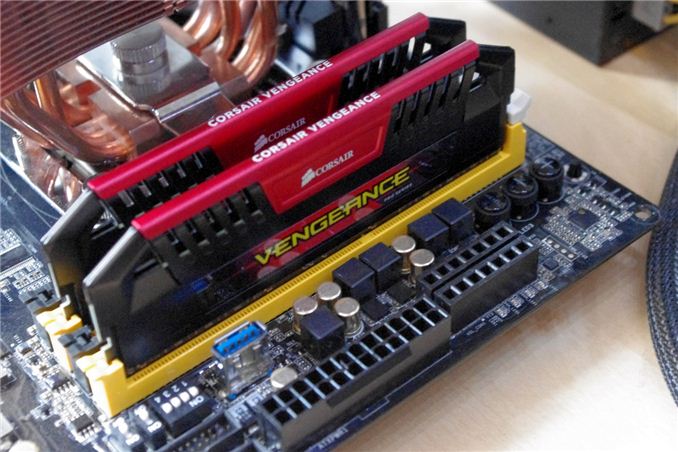
Corsair is a well-known manufacturer of PC components, including DRAM, chassis, power supplies, USB storage, fans, SSDs, gaming peripherals (keyboards, mice, headsets) and cooling, among others. Today we are looking at some of their mid-to-high range memory from their Vengeance Pro range, designed to cater for extreme system builders with DDR3-2400 CAS 10 speeds. This also happens to be the memory we have been using for Haswell motherboard reviews.
Corsair Vengeance Pro 2x8GB DDR3-2400 C10 1.65V Overview
Corsair has been a long time player in the DRAM market, along with Kingston, Crucial and a few others. Several years ago you were hard pressed to find anyone in the PC building business who would not recommend Corsair – it was very often the case that the big names make the big bucks. Despite this, a recent trend among overclocking enthusiasts has developed pushing away from the big names to focus on the newer brands that are more adventurous with their module binning and aggressive with their pricing. Corsair products still hold #2 and #3 spots in terms of user choice, with ~20% of users deciding to test their system with a Corsair memory kit.
In the case of memory, as reliability rates now are extremely high for anyone not overclocking, there are several main battlegrounds: warranty, price and aesthetics. Beauty is supposedly in the eye of the beholder – some users care about the look of the memory fits into their system, whereas others will enjoy a low price to spend another $20 on something else in the system. Corsair’s Vengeance Pro Series comes in several colors (red, blue, silver, gold), and this particular red kit is not available on Newegg (the 2400 C11 kit does, at $220), but does feature on Corsair’s website for $230. Unfortunately for Corsair, Newegg lists a 2x8 GB 2400 C10 kit for $150 (reduced from $170) for sale, alongside a $280 2400 C10 Dominator Platinum kit, and there are plenty of 2400 C11 kits around the $150 mark, suggesting that an $80 bump in pricing for the CMY16GX3M2A2400C10R is actually a large stretch in a system build for what are small (if any) gains at most.
In terms of our testing, Corsair supplied us with a pair of kits, and thus we tested 2x8 GB and 4x8 GB configurations. Note that this is not a recommended scenario – memory kits, even listed as the same timings and modules, are not guaranteed to work with each other. When you add density, timings have to be slackened to compensate, which is not taken account for when buying two kits. Only a full on 4x8 GB kit is guaranteed to work in this context – there are plenty of posts on the ROG forums with issues relating to users attempting to put two memory kits together. Our CPU is a good clocker and the modules we received had some headroom such that we did not experience any issues, but your mileage may vary.
2400 C10 does hit a nice sweet spot in our testing, and our kit even overclocked to 2400 C9, representing a lift in Performance Index from 240 to 267 at the 2400 MHz boundary (2600 C10 was not possible though). But for the price, Corsair are resting on their laurels with the name of the brand being what carries them through, especially with system builders.
Specifications
| ADATA | Corsair | Patriot | ADATA | G.Skill | ||
| Speed | 1600 | 2400 | 2400 | 2400 | 2800 | 3000 |
| ST | 9-11-9-27 | 11-13-13-35 | 10-12-12-31 | 10-12-12-31 | 12-14-14-36 | 12-14-14-35 |
| Price | £125 | $200 | $230 | $92 | $316 | $520 |
| XMP | Yes | Yes | Yes | Yes | Yes | Yes |
| Size | 2 x 8GB | 2 x 8GB | 2 x 8GB | 2 x 4GB | 2 x 8GB | 2 x 4GB |
|
Performance Index |
178 | 218 | 240 | 240 | 233 | 250 |
|
|
||||||
| MHz | 1600 | 2400 | 2400 | 2400 | 2800 | 3000 |
| Voltage | 1.35 V | 1.65 V | 1.65 V | 1.65 V | 1.65 V | 1.65 V |
| tCL | 9 | 11 | 10 | 10 | 12 | 12 |
| tRD | 11 | 13 | 13 | 12 | 14 | 14 |
| tRP | 9 | 13 | 13 | 12 | 14 | 14 |
| tRAS | 27 | 35 | 31 | 31 | 36 | 31 |
| tRC | 38 | 46 | 61 | 43 | 49 | |
| tWR | 12 | 20 | 20 | 16 | 16 | |
| tRRD | 280 | 315 | 315 | 301 | 391 | |
| tRFC | 5 | 6 | 10 | 7 | 7 | |
| tWTR | 6 | 10 | 10 | 10 | 12 | |
| tRTP | 6 | 10 | 10 | 10 | 12 | |
| tFAW | 24 | 33 | 46 | 26 | 29 | |
| CR | - | 2 | 2 | 3 | 2 | |
2400 C10 already comes out high on the Performance Index scale at 240, although based on the subtimings here we can see that the tRFC and tRC are actually very loose, compared to the Patriot (2x4GB) and ADATA (2x8GB C11) kits we have tested. Typically tRFC is a timing that helps with benchmark results and needs to be low to be the best, but at 10 we are not going to set any records here. Interestingly enough the ASRock Z87 OC Formula gives the XMP primary timings as 10-13-13 rather than the 10-12-12 listed on the modules.
Visual Inspection
In a trend that I like, memory manufacturers are making their kits easy to get in to. Similar to one of our previous memory reviews, Corsair places their modules in an easy to open plastic clamshell, which in turn comes in a card-like packaging which shows the module details through a transparent window.
There is a sizable addition in z-height to the modules, which will impact some large coolers including my TRUE copper when mounted for airflow bottom-to-top.


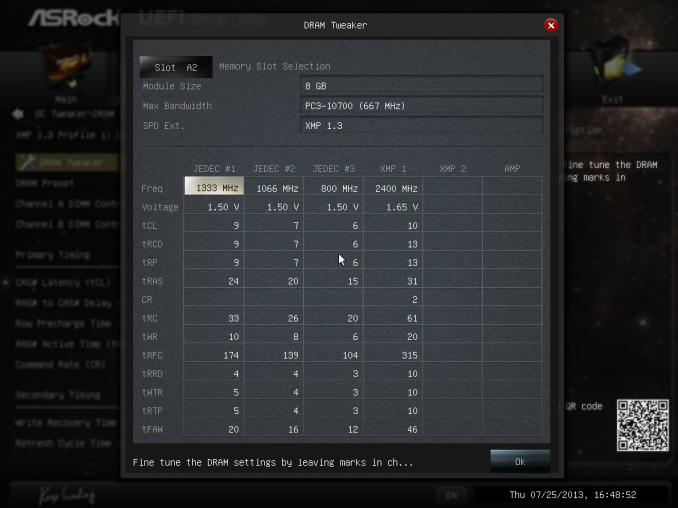
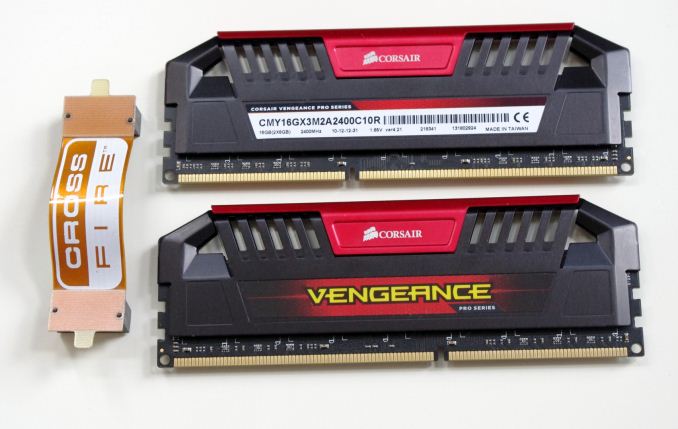
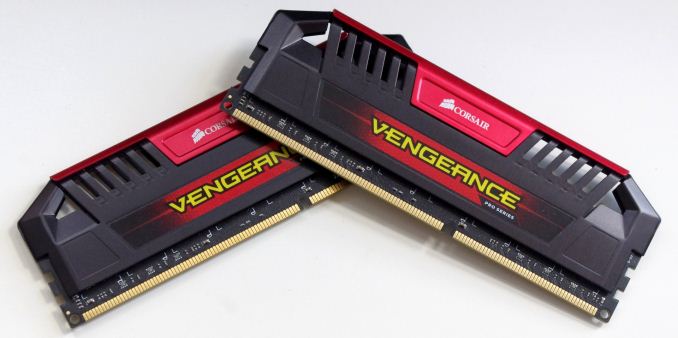
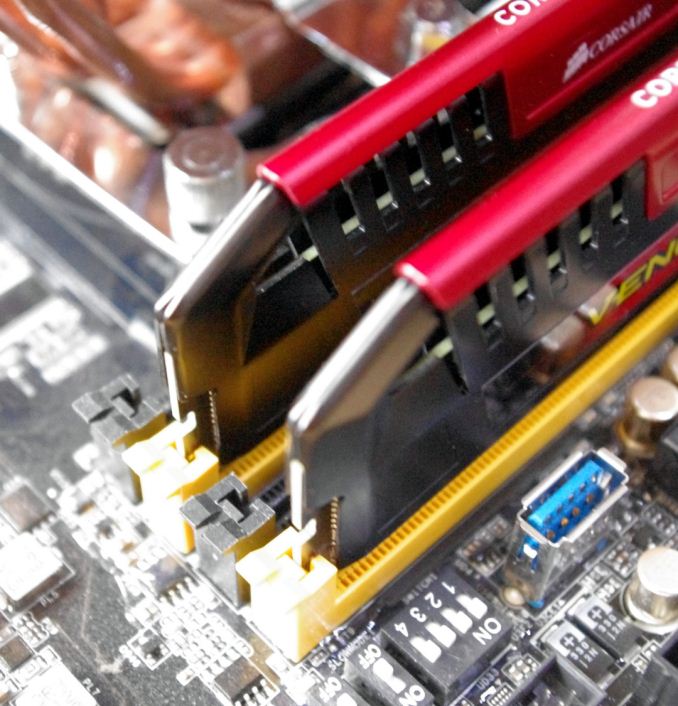














26 Comments
View All Comments
Hairs_ - Saturday, December 14, 2013 - link
A crossfire test is absolutely a valid metric, and testing with older generations of cpu and gpu is something I'm wholly in favour of. My issue is that if someone was buying a dual gpu setup, they would match the cards. If they upgraded after a time differential due to a budget concern, they might mix generations. I don't see a scenario where someone is buying dual+single, however, because if you had the budget to go for a top of the line dual card, you'd be better off with two cheaper cards in crossfire.Would people still have 4 gen old setups? Absolutely! Would they mix and match cards to suit a tight budget? Sure. Would any retail buyer follow *this* pattern? Vanishingly unlikely.
Egg - Sunday, December 15, 2013 - link
Wait, why wouldn't you use a 5970 and a 5870? Sure you lose a bit on clock speeds but it's exactly the same as triple 5870 otherwise, isn't it? And you save some slots.Perhaps someone wanted to do a really expensive water cooled microATX build with 4 slots. IDK, but it doesn't sound that farfetched in practice.
I haven't done this, or CF'ed anything at all, so this is just my two cents...
Hairs_ - Sunday, December 15, 2013 - link
Why? Like I said, there's no physical reason why you *couldn't*, but people use crossfire/sli for the same reason people overclock: to get top-line performance out of a smaller budget. The other use scenario is someone who wants bragging rights and doesn't care about the cost.For the primary, that user is not going to pay for a top line dual card when they could get similar numbers from two lower end cards. For the secondary use case, if money is no object (which it would have to be), why wouldn't you have bought two 5970's?
This example doesn't fit into any consumer behavior, so I have no idea why it would be used as a test.
Giffs - Friday, December 13, 2013 - link
No idea if there is any point in using winrar 4.2But there is winrar 5.01 why not using the latest version? wouldn't it bring improvements on the software side and more accurate results of some sorte??
sinPiEqualsZero - Saturday, December 14, 2013 - link
Thanks for the writeup. I'm shopping for memory and am happy I got to read this first.Also, I noticed an issue: " More expensive kits do not always equal performance, and as our benchmarks go, higher specification kits might also have little affect" should be effect with an e.
Thanks, Ian!
Hairs_ - Saturday, December 14, 2013 - link
There's no "might" about it. High spec kits make NO difference.Hairs_ - Saturday, December 14, 2013 - link
I wonder how it is that the entirely arbitrary "Performance Index" which was devised for memory testing isn't at all borne out by real-world data. Yet the bald statement"From the data in our memory overview, it was clear that any kit with a performance index of less than 200 was going to have issues on certain benchmarks. The Corsair kit has a PI of 240, which is at the higher end of the spectrum."
is still maintained.
There are no facts to back this statement up, as proved in the tests. Are Anandtech reviews going to continue to ignore factual data in favour of preconceived assumptions? I hope not.
Ytterbium - Saturday, December 14, 2013 - link
Explicit Finite Difference, in this graph you have 1333 C9 mid pack and 1866 C9 at bottom, I assume this is typo?Hairs_ - Saturday, December 14, 2013 - link
if you look at all the graphs, the results aren't consistent at all. The kit that top one graph can be bottom of the next. Furthermore, the differences between top and bottom scoring kits is negligible in almost all tests, so many of the differences in rank can be due to statistical variance rather than a meaningfully measured performance difference.E.g. in many tests, the fastest kit in terms of headline mhz (3ghz) is beaten by theoretically slower stuff.
Gen-An - Saturday, December 14, 2013 - link
I wonder if Corsair has purposely set out to make this kit look bad. Every single review I've seen of the Vengeance Pro 2x8GB 2400C10 kit has been Ver4.21, which uses Samsung 4Gbit B-die ICs and are infamous for not being able to clock much higher than about DDR3-2500 or so. I have four sticks of these and they are Ver5.29 using Hynix 4Gbit MFR and I've done Super Pi 32M runs at DDR3-3000 12-15-15-45 and they are rock solid at DDR3-2666 11-13-13.